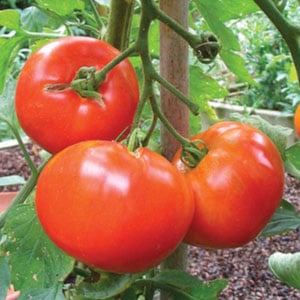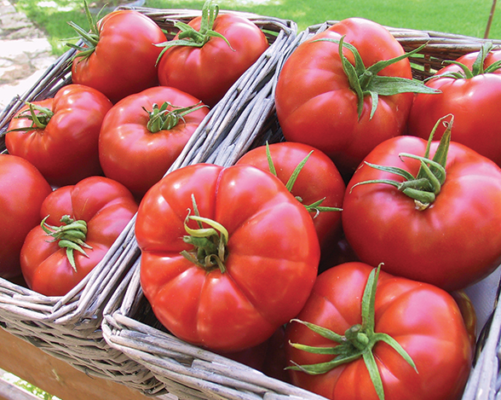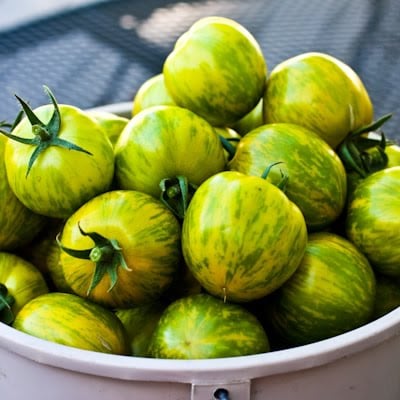
Learning Download: How to Grow Tomatoes
From Seed to Harvest: A guide to growing tomatoes.
Tomatoes are one of the most common plants grown in the garden, but they are usually grown from transplants bought at the store and not seeds. However, growing a tomato from seed allows for more options when it comes to the type of tomatoes a gardener wants to grow. Tomatoes range from typical red to yellow to seedless and heirloom varieties. Homegrown tomatoes taste delicious fresh, or they can be used for canning, sauces and other recipes.
To plant:
Tomatoes can be planted indoors six to eight weeks before the last frost date. Plant them 1/4 inch deep in a seed-starting soil and keep them near a heat source until sprouts appear. Once sprouted, move to a window that receives full light. To get an earlier start outdoors, plant the tomato seeds in cold frames or raised beds.
To grow:
Transplant tomato seedlings outdoors two to three weeks after the last frost date. To encourage a strong plant, bury at least two-thirds of the stem when planting. Tomatoes like full sun and plenty of water, at least 1 inch per week. Always water the base of the plant and not the leaves. Tomato plants do best in a crumbly, loamy soil with a pH of 6.2 to 6.8. To retain moisture and deter weeds, add 2 to 4 inches of mulch around the tomato plants. Tomato plants need to be staked, so use a stake, cage or trellis when you first transplant the seedlings so not to damage the plants later on.
Sometimes, tomato plants can fall victim to the tomato hornworm, which is a big, green caterpillar that eats the leaves and can damage the fruit of the plant. Be sure to rid plants of hornworms or use insecticides to protect the garden. Tomatoes also grow well in pots.
To harvest:
Tomatoes are ripe when they have reached the right color – red for red tomatoes, yellow for yellow tomatoes and so on – and are slightly soft when squeezed. This is usually 65-80 days after planting. The color should be even across the entire tomato, but green tomatoes can be harvested and used to make fried green tomatoes. Tomatoes ripen from the inside out, so if the outside looks ripe that means the inside is as well.
To harvest, grasp the tomato firmly but gently and twist it off the vine. If you are concerned about harming the plant, garden prunes or a knife can be used to cut the stem close to the fruit. Tomatoes should be stored at room temperature until used.
What tomatoes crave:
When seedlings are still inside and once they form their first set of true leaves, you can apply quarter-strength water-soluble fertilizer. As you prepare the holes for the tomato transplants in the garden, mix a continuous-release fertilizer enriched with calcium into the soil. Also mix in 3 to 4 inches of compost prior to planting. Once plants are established and the first fruits begin to appear, fertilize regularly using a 5-10-5 fertilizer once or twice a month. Be careful to not use too much nitrogen, as this can cause leafy plants with little fruit.
Where to buy tomato seeds:
You can find countless options of tomato seeds at Urban Farmer.
Learning Download: Common pests and diseases: Tomatoes
Common pests and diseases: Tomatoes
When growing vegetables, it is always exciting to care for the plant throughout its growing phase and then harvest it for delicious recipes later on, but one thing to watch out for is pests and diseases. Different plants are susceptible to different types of pests and diseases, and it is important to make yourself aware so you can keep a watchful eye and also take any preventative methods to keep your plants safe throughout their lifespan.
Tomatoes can fall victim to several different pests and diseases.
Pests:
Some of the common pests affecting tomato plants include aphids, the beet armyworm, the Colorado potato beetle and the tomato hornworm.
Aphids will be soft-bodied insects usually showing up on the undersides of the leaves. They will be green or yellow in color. The aphids secrete a sticky substance which can cause mold. Knock the aphids off the leaves with a jet of water. Only use insecticides if the infestation is out of control.
The beet armyworm will cause singular or multiple closely group holes in the foliage of the plant. Apply Bacillus thuringiensis and encourage natural enemies.
The Colorado potato beetle can cause complete defoliation if the infestation is bad enough. The adult beetles will emerge in the spring, and they can lay eggs in up to two dozen at a time. The eggs are laid on the undersides of the leaves. Most of these beetles have insecticide resistance, but if you plant early-maturing tomatoes, they may escape damage. Spinosad is effective against the adult beetles.
The tomato hornworm is a big green worm that can cause heavy feeding damage on the leaves or completely strip the leaves from the plant. To treat, handpick the larvae from the plant and promote the population of natural enemies. Use bacillus thuringiensis only when an infestation is out of control.
Diseases:
Some of the common diseases affecting tomatoes include anthracnose, zippering and sun scald.
Anthracnose causes circular lesions on the fruit, and sometimes these lesions can expand to cover the entire fruit’s surface. Plant disease-free seed and treat seeds with hot water prior to planting. Practice crop rotation and make sure you plow all debris into the soil after harvest to help prevent inoculum in the soil. Anthracnose is found in most vegetable-growing areas and can cause large losses to crops if untreated.
Zippering causes brown scars from the petiole to the blossom end of the fruit and holes may appear. Grow tolerant varieties to prevent this from happening.
Sun scald causes white or yellow necrotic patches more commonly on the red fruit on the side that faces the sun. To prevent this, promote healthy plants with full foliage which makes tomatoes less likely to be victims of sun scald.
Learning Download: How to top graft tomatoes | How to side graft tomatoes
How to graft tomatoes
Grafting is a technique often used with trees, such as apple trees, to join two parts of a plant together by tissue regeneration. However, it can also be used in other plants, such as tomatoes. Grafting is done on tomatoes in order to provide more disease-resistant varieties, and it can also reduce the need to use pesticides. The process of top grafting tomatoes can take from 6-8 weeks.
Pick the right rootstock to use, and sow your seeds indoors 6 to 8 weeks before the transplant date. Once the seeds have germinated, wait 10 days and then reduce the temperature to 64 to 66 degrees to encourage the plants to grow stocky. Overplant your seeds by at least 25 percent.
The seedlings should be ready for grafting about 17 to 21 days after you sow the seeds. Use a grafting clip to decide if the plants are ready or not, and when you put the grafting clip on the stem of the seedling, the seedling is ready when the clip fits snugly. Prepare a clean area indoors and do not graft near a fan or a vent. Graft with new blades and clips, and don’t smoke while grafting or you may pass the Tobacco Mosaic Virus to your plants. Make sure you have a healing chamber to store your plants in following the graft. A healing chamber will keep the plants in a high-humidity, low-light controlled environment as they heal.
Water your plants normally the day before grafting, but don’t water the day of the procedure.
To graft, take a double-edged razor blade and snap it in half lengthwise while it is still in its cover. Take your rootstock plant with a stem thickness that matches the grafting clips, and cut at a 45-degree angle below the cotyledons. Find your scion and cut at the same angle and discard the root ball. Sometimes, people will defoliate the leaves of the scion except for the leaf at the growing point. Place a grafting clip halfway over one of the cut stems and join the two together. Make sure there is no dirt or air between the cut surfaces because then the plant won’t heal. Return the seedling to its flat. Move the plants to the healing chamber and keep the chamber closed for three days. Keep it in the dark for 24 hours and then use soft light.

On the fourth day, check to see if the plants are still moist and then close the tunnel. Make a small opening in the chamber on the fifth day so some of the humidity can escape, and then gradually bring the grafted tomatoes into a greenhouse. The silicone grafting clips will expand as the plant grows and then fall off by themselves.
Side grafting varies slightly from the top grafting, but much of the process remains the same. Select a rootstock and a scion of similar size, and the defoliate the lower leaves of each piece. Then, cut off the top of the rootstock by making an upward cut about two-thirds of the way through the rootstock’s stem. Make a downward cut on the scion two-thirds of the way through the stem, as well. Line the incisions up together, side by side, and place a grafting clip over the incisions. Put the plants in a pot that is large enough to hold both root balls to reduce the stress on the plant. Keep the plants in the healing chamber for three days, and then prepare to cut the scion’s root ball. Attach the seedlings to a stake for stabilization and then cut partway through the scion’s stem, but not all the way. Replace the healing chamber dome and wait two more days before you fully cut the stem. Once the root is severed from the scion, put the graft in normal greenhouse conditions. The best time to introduce the graft into the greenhouse is in the evening or on a cloudy day.
Learning Download: Heirloom Tomato Comparison Chart
Heirloom Tomato Comparison Chart
| Color | Variety | Days | Size | Disease Resistance |
| Red | Red Oxheart | 75-85 | 16-32 oz. | |
| Red | Red Pear | 75 | 1 oz. | |
| Red | Rio Grande | 77 | 3 oz. | |
| Red | Abe Lincoln | 80 | 12 oz. | ASC, FW, GLS, RKN, VW |
| Red | Trip-L-Crop | 85 | 12-24 oz. | FW, TMV, VW |
| Red | Ace 55 | 80 | 12 oz. | ASC, FW, GLS, RKN, VW |
| Red | Amish Paste | 85 | 8-12 oz. | |
| Red | Federle | 75 | 3-5 oz. | |
| Red | Floradade | 75 | 5-7 oz. | |
| Red | Large Red Cherry | 75 | 1 oz. | |
| Red | Marglobe Supreme | 75 | 4-6 oz. | FW, VW |
| Red | Mortgage Lifter | 82 | 16-48 oz. | |
| Red | Red Currant | 70 | .25 oz. | |
| Red | Roma | 75 | 3-4 oz. | ASC, FW, RKN, VW |
| Red | Rutger | 75 | 6-10 oz. | |
| Red | Sweetie | 50 | .5 oz. | |
| Pink | Aunt Ginnys Purple | 80 | 8-16 oz. | |
| Pink | Pink Brandywine | 90 | 12-20 oz. | EB |
| Pink | Pink Oxheart | 86 | 16-32 oz. | |
| Pink | Ponderosa Pink | 80 | 16 oz. | |
| Pink | Porter | 80 | 2 oz. | |
| Pink | Sudduth’s Strain Brandywine | 90 | 14-28 oz. | |
| Red and Orange | Big Rainbow | 75-85 | 16 oz. | |
| Red and Orange | Isis Candy | 75 | 1-2 oz. | |
| Red and Orange | Pineapple | 90 | 16-32 oz. | |
| Red and Orange | Striped German | 78 | 12-20 oz. | |
| Orange | Amana Orange | 80 | 12-20 oz. | |
| Orange | Kellogg’s Breakfast | 80 | 16-24 oz. | |
| Yellow | Yellow Pear | 70-80 | .5-1 oz. | FW, VW |
| Yellow | Golden Jubilee | 78 | 6-12 oz. | |
| Yellow | Yellow Brandywine | 90 | 12-20 oz. | |
| Green | Tasty Evergreen | 77 | 10-16 oz. | |
| Green | Aunt Ruby German Green | 80 | 16-24 oz. | BER, FW, VW |
| Green | Green Zebra | 75 | 2 oz. | |
| Black | Black Krim | 80 | 8-12 oz. | |
| Black | Black Plum | 70 | 10-16 oz. | |
| Black | Cherokee Purple | 83 | 8-20 oz. |
Diseases:ASC (Alternaria Stem Canker), BER (Blossom End Rot), FW (Fusarium Wilt), EB (Earlt Blight), GLS (Gray Leaf Spot), RKN (Root Knot Nematodes), TMV (Tobacco Mosiac Virus), VW (Verticillium Wilt)
Learning Download: Low Acid Tomatoes
Low-Acid Tomato Comparison Chart
| Variety | Days | Color | Size | Disease Resistance |
| Ace 55** | 80 | red | 12 oz. | ASC, FW, GLS, RKN, VW |
| Big Rainbow** | 75-80 | red/orange | 16+ oz. | EB |
| Golden Jubilee*** | 78 | yellow | 6-12 oz. | |
| Great White | 80 | white | 12 oz. | |
| Jet Star | 72 | red | 6-8 oz. | FW, TMV, VW |
| Lemon Boy | 72 | yellow | 7 oz. | ASC, FW, GLS, RKN, VW |
| Pink Girl | 76 | pink | 6-8 oz. | ASC, FW, GLS, RKN, TMV, VW |
| Ponderosa Pink** | 80 | pink | 16 oz. | |
| San Marzano** | 80 | red | 3-4 oz. | |
| Sun Gold | 55-65 | orange | .5-1 oz. | Fw, TMV, VW |
| Taxi | 64 | yellow | 4-6 oz. | |
| Yellow Pear** | 68-80 | yellow | .5-1 oz. | FW, VW |
*All American Selection Winner
**Heirloom
***AAS Winner/Heirloom
Diseases:ASC (Alternaria Stem Canker), BER (Blossom End Rot), FW (Fusarium Wilt), EB (Earlt Blight), GLS (Gray Leaf Spot), RKN (Root Knot Nematodes), TMV (Tobacco Mosiac Virus), VW (Verticillium Wilt)


